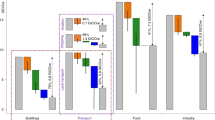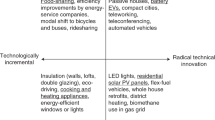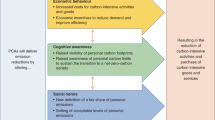Abstract
Rapid action to improve resource efficiency is essential for achieving climate mitigation goals. As they are likely to reshape everyday life in unexpected ways, new products, policies and business models will need to consider the public acceptability of resource-efficiency strategies, as well as the technical emission-reduction potential. Here, using consumption-based emissions modelling and deliberative public workshops, we find considerable public support for a range of resource-efficiency strategies that combined could reduce the carbon footprint in the United Kingdom by up to 29 Mt of CO2-equivalent (CO2e) emissions (a 39% emissions reduction from household products, such as cars, clothing, electronics, appliances and furniture). Public acceptability is already high for strategies that aim to develop more resource-efficient products. Strategies that aim to encourage product sharing and extend product lifetimes were also perceived positively, although acceptance was dependent on meeting other important conditions, such as trustworthiness, responsibility, fairness, affordability, convenience, safety and hygiene.
This is a preview of subscription content, access via your institution
Access options
Access Nature and 54 other Nature Portfolio journals
Get Nature+, our best-value online-access subscription
$29.99 / 30 days
cancel any time
Subscribe to this journal
Receive 12 print issues and online access
$209.00 per year
only $17.42 per issue
Buy this article
- Purchase on Springer Link
- Instant access to full article PDF
Prices may be subject to local taxes which are calculated during checkout

Similar content being viewed by others
Data availability
The UK MRIO raw data cannot be made publicly available, because it makes use of protected data from the Office of National Statistics. We calculate GHG footprints using the MRIO model and have provided the GHG emissions results in Supplementary Data 1b. Assumptions on the ambition and adoption rate of the material productivity strategies are provided in Supplementary Data 1c and the emissions savings are given in Supplementary Data 1d. We will consider requests to share the MRIO tables (for research purposes only) on a case-by-case basis. In relation to the workshops, the audio files and transcripts cannot be made publicly available due to the need to respect participant confidentiality. However, we will consider requests to share the anonymized transcripts (for research purposes only) on a case-by-case basis after an embargo of two years, during which time our analysis continues. Any other data are available from the corresponding author upon reasonable request. The demographic data and deliberative workshop protocol and materials are available in Supplementary Table 1 and Supplementary Methods 1 and 2. Images have been redacted for copyright reasons.
References
Drummond, P. & Ekins, P. Cost-effective decarbonization in the EU: an overview of policy suitability. Clim. Policy 17, S51–S71 (2017).
Scott, K. & Barrett, J. An integration of net imported emissions into climate change targets. Environ. Sci. Policy 52, 150–157 (2015).
Afionis, S., Sakai, M., Scott, K., Barrett, J. & Gouldson, A. Consumption-based carbon accounting: does it have a future? WIREs Clim. Change 8, e438 (2017).
Energy Technology Perspectives 2017 (OECD/IEA, 2017).
IRP Decoupling Natural Resource Use And Environmental Impacts From Economic Growth (UNEP, 2011).
Liu, G., Bangs, C. E. & Müller, D. B. Stock dynamics and emission pathways of the global aluminium cycle. Nat. Clim. Change 3, 338–342 (2013).
Barrett, J. & Scott, K. Link between climate change and resource efficiency. Glob. Environ. Change 22, 299–307 (2012).
Creutzig, F. et al. Urban infrastructure choices structure climate solutions. Nat. Clim. Change 6, 1054–1056 (2016).
Girod, B., van Vuuren, D. P. & Hertwich, E. G. Climate policy through changing consumption choices: options and obstacles for reducing greenhouse gas emissions. Glob. Environ. Change 25, 5–15 (2014).
Pauliuk, S. & Müller, D. B. The role of in-use stocks in the social metabolism and in climate change mitigation. Glob. Environ. Change 24, 132–142 (2014).
Milford, R. L., Pauliuk, S., Allwood, J. M. & Müller, D. B. The roles of energy and material efficiency in meeting steel industry CO2 targets. Environ. Sci. Technol. 47, 3455–3462 (2013).
Owen, A., Scott, K. & Barrett, J. Identifying critical supply chains and final products: an input–output approach to exploring the energy–water–food nexus. Appl. Energy 210, 632–642 (2018).
Barrett, J. et al. Consumption-based GHG emission accounting: a UK case study. Clim. Policy 13, 451–470 (2013).
Giesekam, J., Barrett, J., Taylor, P. & Owen, A. The greenhouse gas emissions and mitigation options for materials used in UK construction. Energy Build. 78, 202–214 (2014).
Cooper, S. J. et al. Thermodynamic insights and assessment of the ‘circular economy’. J. Clean. Prod. 162, 1356–1367 (2017).
Spence, A. & Pidgeon, N. Psychology, climate change & sustainable bahaviour. Environment 51, 8–18 (2009).
Skea, J, Ekins, P. & Winskel, M. Making the Transition to a Secure and Low-Carbon Energy System: UKERC Energy 2050 Project (UKERC, 2009).
Dietz, T., Gardner, G. T., Gilligan, J., Stern, P. C. & Vandenbergh, M. P. Household actions can provide a behavioral wedge to rapidly reduce US carbon emissions. Proc. Natl Acad. Sci. USA 106, 18452–18456 (2009).
Wilson, C. & Dowlatabadi, H. Models of decision making and residential energy use. Annu. Rev. Environ. Resour. 32, 169–203 (2007).
Whitmarsh, L. et al. Public Attitudes to and Engagement with Low-Carbon Energy (Research Councils UK, 2011).
Demski, C., Butler, C., Parkhill, K. A., Spence, A. & Pidgeon, N. F. Public values for energy system change. Glob. Environ. Change 34, 59–69 (2015).
Butler, C., Demski, C., Parkhill, K., Pidgeon, N. & Spence, A. Public values for energy futures: framing, indeterminacy and policy making. Energy Policy 87, 665–672 (2015).
The UK Carbon Plan (Department of Energy and Climate Change, 2011).
Watson, C. Opening up the energy debate. Policy Lab (19 February 2014); https://openpolicy.blog.gov.uk/2014/02/19/opening-up-the-energy-debate/
Guertler, P., Robson, D. & Royston, S. Somewhere between a ‘Comedy of errors’ and ‘As you like it’? A brief history of Britain’s ‘Green Deal’ so far. In ecee Summer Study Proceedings 1-306-13 (ecee, 2013).
Scott, K., Roelich, K., Owen, A. & Barrett, J. Extending European energy efficiency standards to include material use: an analysis. Clim. Policy 18, 1–15 (2017).
Smart Growth: The Economic Case for the Circular Economy (Business in the Community, 2018).
Towards the Circular Economy, Economic and Business Rationale for an Accelerated Transition (Ellen MacArthur Foundation, 2013).
Hatfield-Dodds, S. et al. Assessing global resource use and greenhouse emissions to 2050, with ambitious resource efficiency and climate mitigation policies. J. Clean. Prod 144, 403–414 (2017).
Truelove, H. B., Yeung, K. L., Carrico, A. R., Gillis, A. J. & Raimi, K. T. From plastic bottle recycling to policy support: an experimental test of pro-environmental spillover. J. Environ. Psychol. 46, 55–66 (2016).
Sorrell, S. Jevons’ paradox revisited: the evidence for backfire from improved energy efficiency. Energy Policy 37, 1456–1469 (2009).
Owen, A. et al. Energy consumption-based accounts: a comparison of results using different energy extension vectors. Appl. Energy 190, 464–473 (2017).
UK Standard Industrial Classification of Economic Activities 2007 (Office for National Statistics, 2009).
Miller, R. E. & Blair, P. D. Input–Output Analysis: Foundations and Extensions (Cambridge Univ. Press, Cambridge, 2009).
Wood, R. et al. Prioritizing consumption‐based carbon policy based on the evaluation of mitigation potential using input‐output methods. J. Ind. Ecol. 22, 540–552 (2018).
Sorrell, S. Reducing energy demand: a review of issues, challenges and approaches. Renew. Sustain. Energy Rev. 47, 74–82 (2015).
Chilvers, J. & Mcnaghten, P. The Future of Science Governance — A Review of Public Concerns, Governance and Institutional Response (Univ. East Anglia & Durham Univ., 2011).
Corner, A., Parkhill, K., Pidgeon, N. & Vaughan, N. E. Messing with nature? Exploring public perceptions of geoengineering in the UK. Glob. Environ. Change 23, 938–947 (2013).
Corner, A. et al. Nuclear power, climate change and energy security: exploring British public attitudes. Energy Policy 39, 4823–4833 (2011).
Macnaghten, P. & Szerszynski, B. Living the global social experiment: an analysis of public discourse on solar radiation management and its implications for governance. Glob. Environ. Change 23, 465–474 (2013).
Cherry, C., Hopfe, C., MacGillivray, B. & Pidgeon, N. Homes as machines: exploring expert and public imaginaries of low carbon housing futures in the United Kingdom. Energy Res. Soc. Sci. 23, 36–45 (2017).
Pidgeon, N., Demski, C., Butler, C., Parkhill, K. & Spence, A. Creating a national citizen engagement process for energy policy. Proc. Natl Acad. Sci. USA 111, 13606–13613 (2014).
Macnaghten, P. Researching technoscientific concerns in the making: narrative structures, public responses and emerging nanotechnologies. Environ. Plann. A 42, 23–37 (2010).
Wilmshurst, J. & Mackay, A. Fundamentals of Advertising (Routledge, London, 2010).
Glaser, B. & Strauss, A. The Discovery of Grounded Theory (Weidenfield & Nicolson, London, 1967).
Strauss, A. & Corbin, J. M. Grounded Theory in Practice (Sage, Thousand Oaks, 1997).
Henwood, K. L. & Pidgeon, N. F. Qualitative research and psychological theorizing. Br. J. Psychol. 83, 97–111 (1992).
Charmaz, K. Constructing Grounded Theory: A Practical Guide through Qualitative Analysis. Introducing Qualitative Methods series (Sage, Thousand Oaks, 2006).
Acknowledgements
Funding for this research was provided by the UK Engineering and Physical Sciences Research Council (EPSRC) as part of the Energy Programme, and undertaken by the Centre for Industrial Energy, Materials and Products (CIE-MAP) (grant EP/N022645/1), the related EPSRC collaborative grant (EP/M008053/1) and the UK Natural Environment Research Council (NERC) (grant NE/R012881/1). We thank our CIE-MAP colleagues and partners Green Alliance, whose input and advice has been invaluable throughout the development of this research project.
Author information
Authors and Affiliations
Contributions
C.C., K.S., J.B. and N.P. were involved in the conceptualization of the research; K.S. and J.B. designed the quantitative modelling and methodology; K.S. performed quantitative modelling analyses; C.C. and N.P. designed qualitative workshop and methodology; C.C. performed qualitative data analyses; C.C. and K.S. wrote the original draft; C.C., K.S., J.B. and N.P. were involved in writing, review and editing of the manuscript; J.B. and N.P. acquired funding.
Corresponding author
Ethics declarations
Competing interests
The authors declare no competing interests.
Additional information
Publisher’s note: Springer Nature remains neutral with regard to jurisdictional claims in published maps and institutional affiliations.
Supplementary information
Supplementary Information
Supplementary notes 1–3, Supplementary methods 1–2, Supplementary table 1, Supplementary references
Supplementary Data 1
Includes all supplementary data quantifying emissions savings from the resource-efficiency strategies: Descriptions of strategies, Baseline scenarios, Case study descriptions, Emissions savings by case study, Emissions savings by strategy, Adoption and ambition analysis, Results summary
Rights and permissions
About this article
Cite this article
Cherry, C., Scott, K., Barrett, J. et al. Public acceptance of resource-efficiency strategies to mitigate climate change. Nature Clim Change 8, 1007–1012 (2018). https://doi.org/10.1038/s41558-018-0298-3
Received:
Accepted:
Published:
Issue Date:
DOI: https://doi.org/10.1038/s41558-018-0298-3
This article is cited by
-
Planning sustainable carbon neutrality pathways: accounting challenges experienced by organizations and solutions from industrial ecology
The International Journal of Life Cycle Assessment (2023)
-
Review Study of Energy Efficiency Measures in Favor of Reducing Carbon Footprint of Electricity and Power, Buildings, and Transportation
Circular Economy and Sustainability (2023)
-
Modeling drivers for successful adoption of green business: an interpretive structural modeling approach
Environmental Science and Pollution Research (2021)



